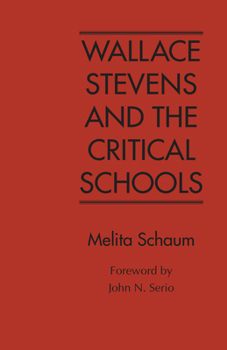Wallace Stevens and the Critical Schools
Select Format
Select Condition 
Book Overview
An overview of seventy years of Stevens criticism Wallace Stevens and the Critical Schools reveals a field marked by conflict and contradiction, both within and among critical works in their attempts to explicate and appropriate this major American poet. Stevens' changing reception among the critical schools reveals much about the shifting nature of American literature and criticism in this century and illuminates the often polemical process of literary canon formation. Each chapter of this book examines a particular aspect of the 20th-century critical involvement with Wallace Stevens' poetry, introduced by a discussion of the poet's work as an arena for the convergence of modern critical tendencies and concerns. First, the author examines the avant-garde milieu of early 20th-century modernism, which implicated Stevens in its melee of affiliations and enmities and which influenced critics' ambivalent responses to his early work. She traces the critical controversies of the poet's emergence before and during the 1920s, specifically the clash between New Humanism and aestheticism, and demonstrates how the quality of irony in Stevens' work became a part of the critics' general repertoire in their assessment of this poet. The 1930s, 1940s, and 1950s were decades during which Stevens criticism became dominated by the New Critical ideology. The turn toward deconstruction in Stevens criticism stands in part as a response to the New Critical dilemma, seen in the manner in which such critics as J. Hillis Miller and Joseph Riddel appropriated the concept of "decreation" to explain the sense of rupture in Stevens' late poetry yet brought that concept to its logical end in a deconstructive paradigm. Finally, Schaum identifies four major theoretical approaches to Stevens in the past two decades that continue to inform and direct the field of critical dissent and exploration in the 1980s. Such theories as Bloomian misprision, versions of hermeneutic criticism, redefinitions of the deconstructive enterprise, and the contemporary call for a new historicism continue the battle to appropriate Stevens as the "hard prize" of critical aims and investigations.
Format:Paperback
Language:English
ISBN:081735008X
ISBN13:9780817350086
Release Date:August 2003
Publisher:University Alabama Press
Length:224 Pages
Weight:0.66 lbs.
Dimensions:0.7" x 5.2" x 8.8"
Customer Reviews
0 rating





